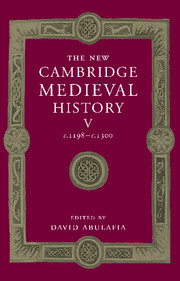Book contents
- Frontmatter
- Introduction
- Part I Common Themes
- Part II The Church in the Thirteenth Century
- Part III The Western Kingdoms
- 11 The Capetians from the death of Philip II to Philip IV
- 12 The Plantagenet kings
- 13 The kingdom of Burgundy, the lands of the house of Savoy and adjacent territories
- 14 Germany and Flanders
- (a) Welfs, Hohenstaufen and Habsburgs
- (b) Flanders
- Part IV Italy
- Part V The Mediterranean Frontiers
- Part VI The Northern and Eastern Frontiers
- Appendix Genealogical tables
- Primary sources and secondary works arranged by chapter
- Index
- Plate section
- Map 1 Europe in the thirteenth century
- Map 3 France, c. 1260
- Map 5 Germany and the western empire
- Map 6 Genoa, Venice and the Mediterranean
- Map 8 The Latin empire of Constantinople and its neighbours
- Map 10 Aragon and Anjouin the Mediterranean">
- References
(b) - Flanders
from 14 - Germany and Flanders
Published online by Cambridge University Press: 28 March 2008
- Frontmatter
- Introduction
- Part I Common Themes
- Part II The Church in the Thirteenth Century
- Part III The Western Kingdoms
- 11 The Capetians from the death of Philip II to Philip IV
- 12 The Plantagenet kings
- 13 The kingdom of Burgundy, the lands of the house of Savoy and adjacent territories
- 14 Germany and Flanders
- (a) Welfs, Hohenstaufen and Habsburgs
- (b) Flanders
- Part IV Italy
- Part V The Mediterranean Frontiers
- Part VI The Northern and Eastern Frontiers
- Appendix Genealogical tables
- Primary sources and secondary works arranged by chapter
- Index
- Plate section
- Map 1 Europe in the thirteenth century
- Map 3 France, c. 1260
- Map 5 Germany and the western empire
- Map 6 Genoa, Venice and the Mediterranean
- Map 8 The Latin empire of Constantinople and its neighbours
- Map 10 Aragon and Anjouin the Mediterranean">
- References
Summary
DYNASTY AND TERRITORY
UNDER Count Philip of Alsace (1157–91), Flanders had become one of the mightiest and most progressive principalities of western Europe. Although a vassal of the king of France, Philip could compete with him, especially since the succession of his wife Elisabeth of Vermandois in 1163 had extended his territories from the mouth of the Scheldt to only twenty-five kilometres north of Paris. In fact, he held a patrimony larger and probably richer than the royal domains of France. Only the Angevin kings of England and dukes of Normandy were even more powerful vassals of the French crown. However, in 1185 Philip had to give up Vermandois after his wife’s death; he remained childless and his two brothers died before him. He sought his destiny in personal glory, taking part in the Third Crusade, and died before Acre in 1191. He had secured his succession by Baldwin V, count of Hainault, who was the consort of his sister. In order to obtain his suzerain’s approval, Philip had arranged Philip Augustus’s marriage with his niece Isabel of Hainault in 1180, for which he offered as a dowry a great number of his cities and castellanies which in 1237 were to be formed into the county of Artois.
So, in 1191, the power relations between Flanders and France had radically been reversed: the king now constantly undermined the counts’ power. Flanders lost the southern and perhaps most developed part of its territory, with such large and rich cities as Arras and Hesdin, while the final agreement in 1212 tore off Flanders the equally important cities and castellanies of Saint-Omer and Aire. Exactly one century later, Flanders would again lose to France three of its southern cities with their territories, namely Lille, Douai and Orchies. These substantial losses clearly demonstrate the constant and successful pressure the crown exerted on its peripheral fief during the whole of the thirteenth century.
Keywords
- Type
- Chapter
- Information
- The New Cambridge Medieval History , pp. 405 - 416Publisher: Cambridge University PressPrint publication year: 1999
References
- 2
- Cited by

